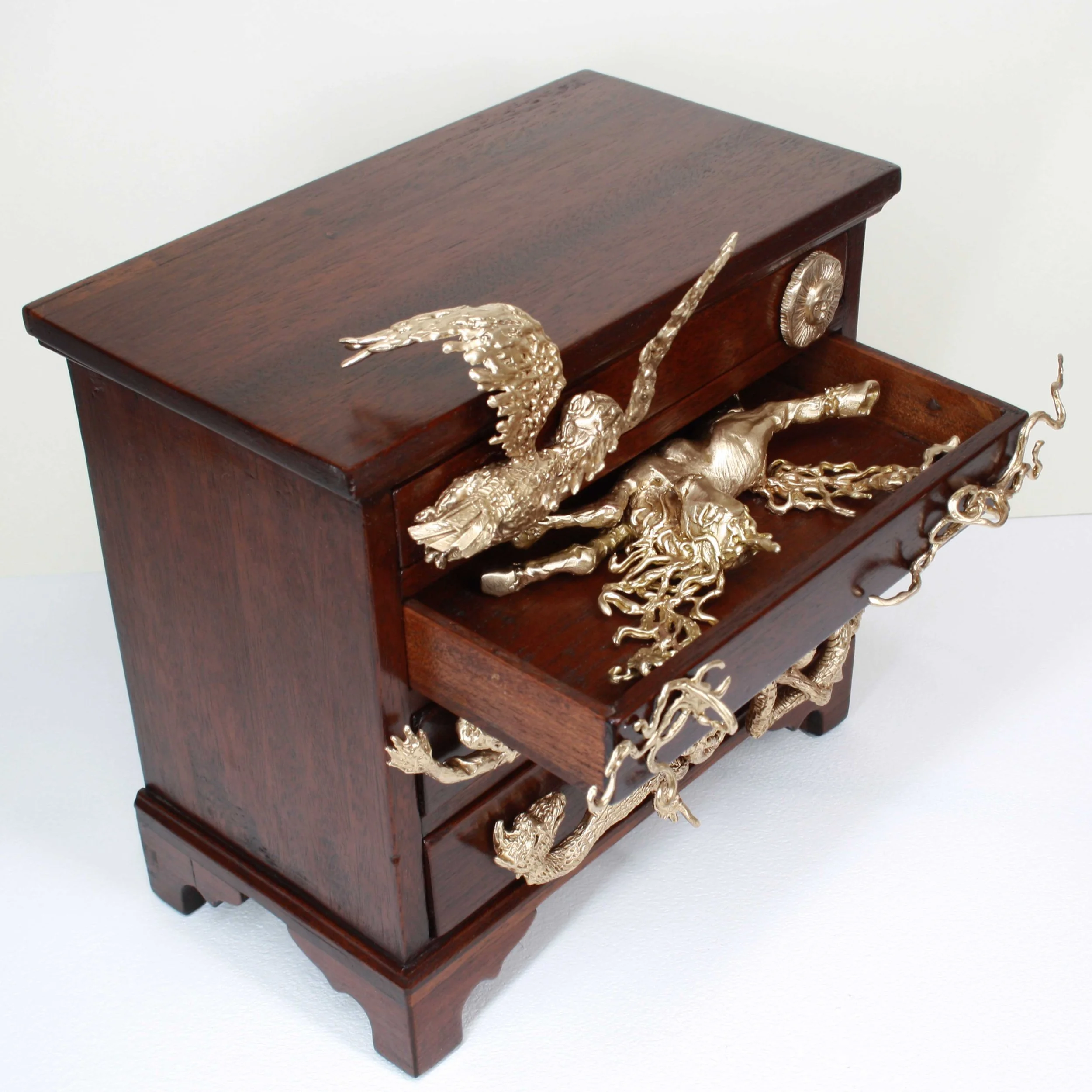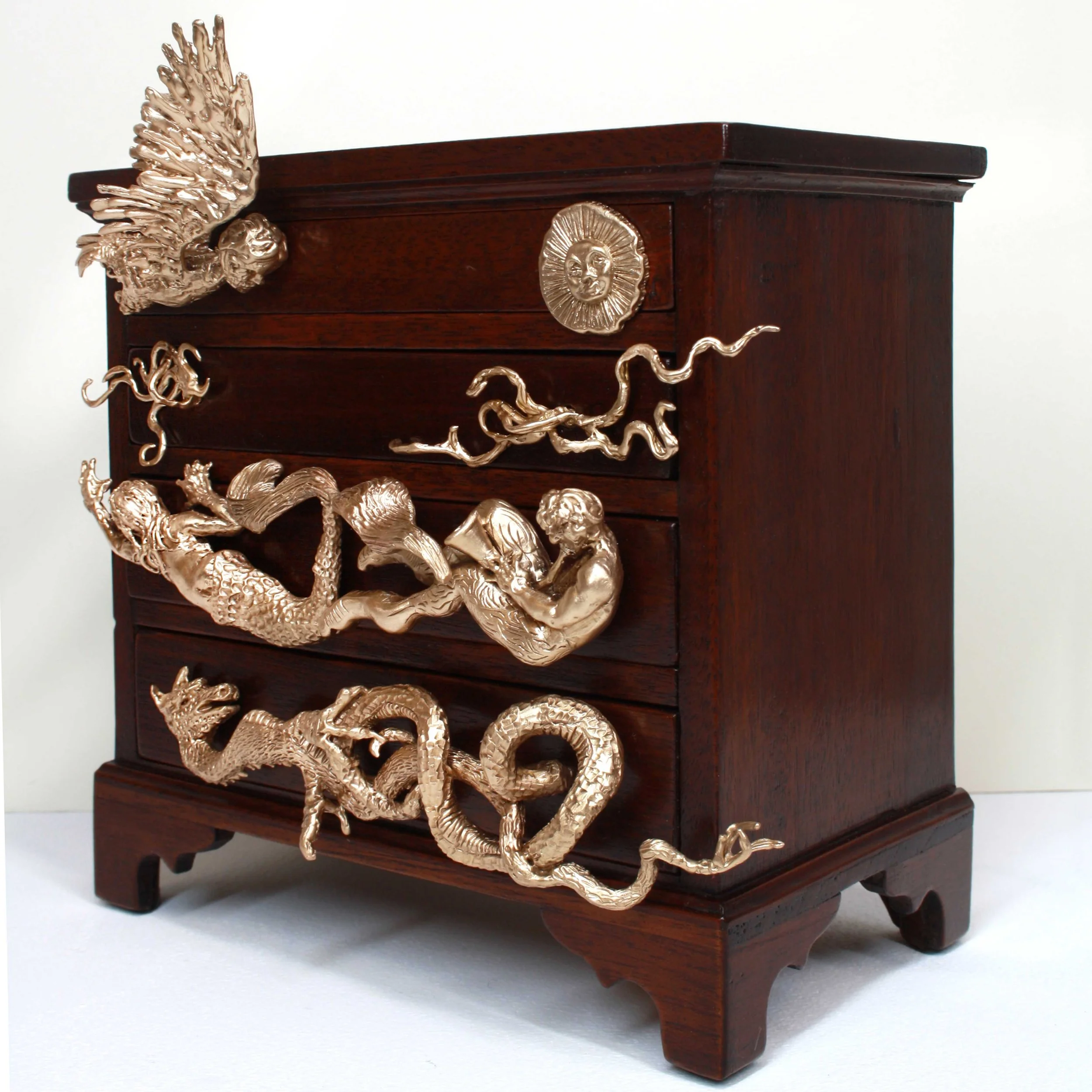




Shrine to the Myth
Mythologist Joseph Campbell- “By a monster I mean some horrendous presence of apparition that explores all of your standards for harmony, order, and ethical conduct” (1968)
A cabinet of curiosities style presentation, each creature is confined to a drawer. From the 16th Century, cabinets contained ‘real-life’ mythical beasts, and even though many were sceptical, there was a growing excitement at the time of believing in something beyond humanity. In a religious world, people were more open to having faith in that which they could not see. These monsters had a function; to warn of straying from the path, indulging in sinful traits, and the power of community coming together to defeat ‘evil’. The strength of this belief is visible in the strong popularity of curiosities well into the 18th Century, even after these creatures began to be discredited.
Denouncing mythical ‘curiosities’ as taxidermy hoxes, the monsters became a symbol of the power of The Enlightenment and the progress of reason, and fuelled the consensus to change past ways of thinking to become more knowledgeable about the natural world.
Traditional myths feature humans and mythical beings clashing. Myths give way to explore primal human needs and emotions; to understand the significance of monsters, it is necessary to highlight the fear and anxiety we feel about the part of ourselves reflected in the beasts. These creatures feed the uncanny- part horror and part reverence, we must recognise The Other in them. The new myth in our age is not human-monster, but human-machine. In this context, the need to hold onto historical myths is Romantic.
Shrine to the Myth offers the value of remembering the wonder we once had in the unknown; having the ability to believe in something otherworldly brings perspective, wonder, and curiosity. Each beast is preserved in bronze permanence, so we don’t lose them in a world focused on transhuman progress.
Featuring a literarily impossible amalgamation of creatures- conventional myths have one, maybe two, of these beasts, one is confronted when looking at the piece. Unable to contextually place each being, the senses are overloaded allowing us to experience a childlike wonder and joy. By overburdening the piece, a single story cannot be grasped, and the box lays dormant until human interaction brings the creatures, and stories, to life.
The narrative of the box is placed in the human hand; depending on how the drawers are opened, and it each order, the creatures interact with each other, and the user. One must physically grab a beast to pull the drawer out, highlighting how intertwined we are with our history, and solidifying the view that Myths’ have a function in our modern world.
Mythologist Joseph Campbell- “By a monster I mean some horrendous presence of apparition that explores all of your standards for harmony, order, and ethical conduct” (1968)
A cabinet of curiosities style presentation, each creature is confined to a drawer. From the 16th Century, cabinets contained ‘real-life’ mythical beasts, and even though many were sceptical, there was a growing excitement at the time of believing in something beyond humanity. In a religious world, people were more open to having faith in that which they could not see. These monsters had a function; to warn of straying from the path, indulging in sinful traits, and the power of community coming together to defeat ‘evil’. The strength of this belief is visible in the strong popularity of curiosities well into the 18th Century, even after these creatures began to be discredited.
Denouncing mythical ‘curiosities’ as taxidermy hoxes, the monsters became a symbol of the power of The Enlightenment and the progress of reason, and fuelled the consensus to change past ways of thinking to become more knowledgeable about the natural world.
Traditional myths feature humans and mythical beings clashing. Myths give way to explore primal human needs and emotions; to understand the significance of monsters, it is necessary to highlight the fear and anxiety we feel about the part of ourselves reflected in the beasts. These creatures feed the uncanny- part horror and part reverence, we must recognise The Other in them. The new myth in our age is not human-monster, but human-machine. In this context, the need to hold onto historical myths is Romantic.
Shrine to the Myth offers the value of remembering the wonder we once had in the unknown; having the ability to believe in something otherworldly brings perspective, wonder, and curiosity. Each beast is preserved in bronze permanence, so we don’t lose them in a world focused on transhuman progress.
Featuring a literarily impossible amalgamation of creatures- conventional myths have one, maybe two, of these beasts, one is confronted when looking at the piece. Unable to contextually place each being, the senses are overloaded allowing us to experience a childlike wonder and joy. By overburdening the piece, a single story cannot be grasped, and the box lays dormant until human interaction brings the creatures, and stories, to life.
The narrative of the box is placed in the human hand; depending on how the drawers are opened, and it each order, the creatures interact with each other, and the user. One must physically grab a beast to pull the drawer out, highlighting how intertwined we are with our history, and solidifying the view that Myths’ have a function in our modern world.
This piece is signed
Dimensions: 19 x 14 x 21 cm